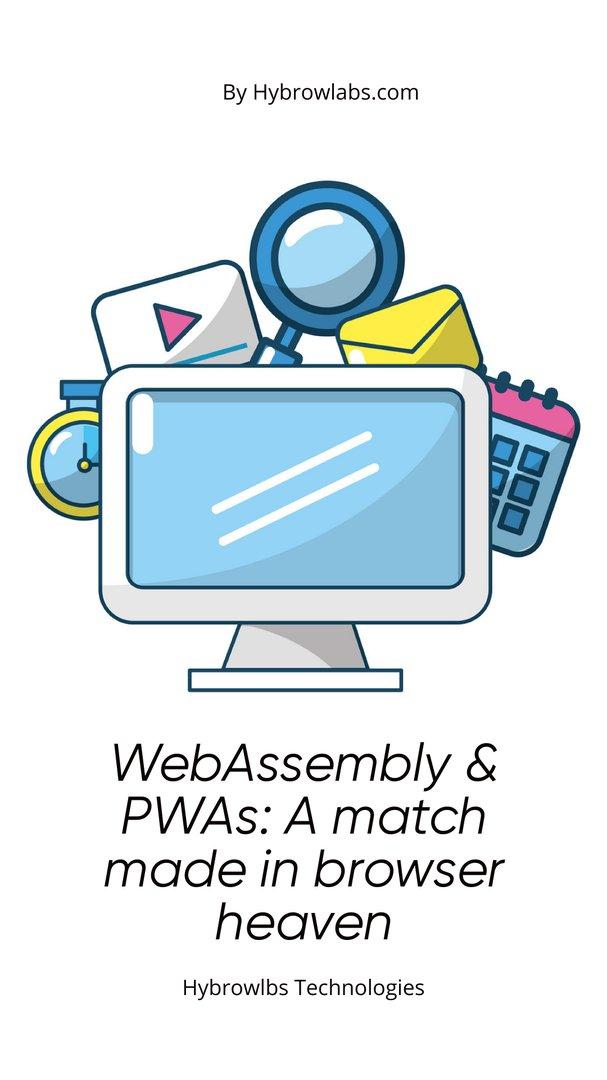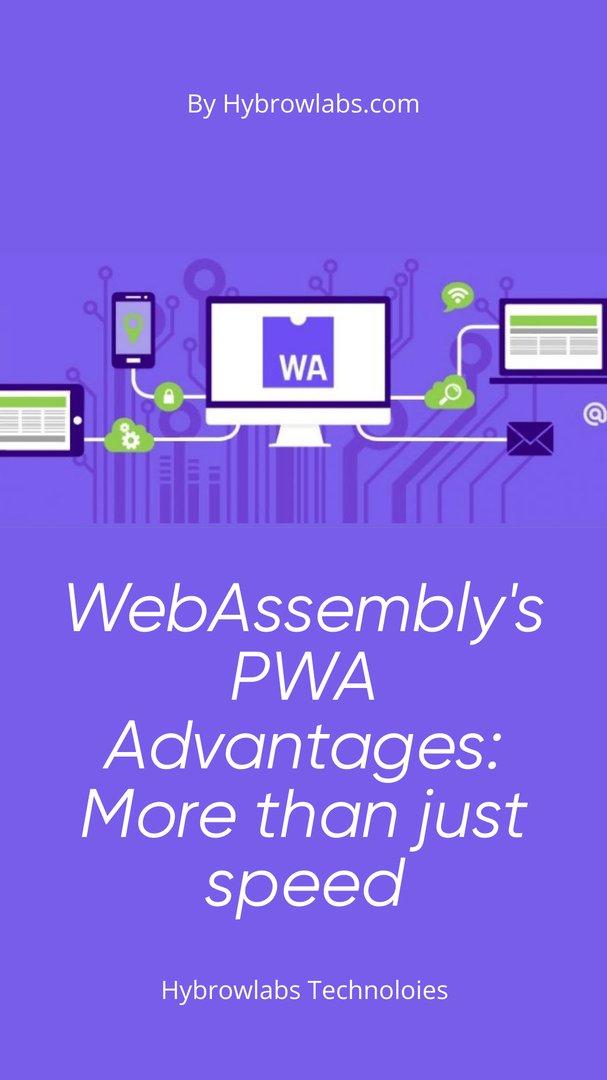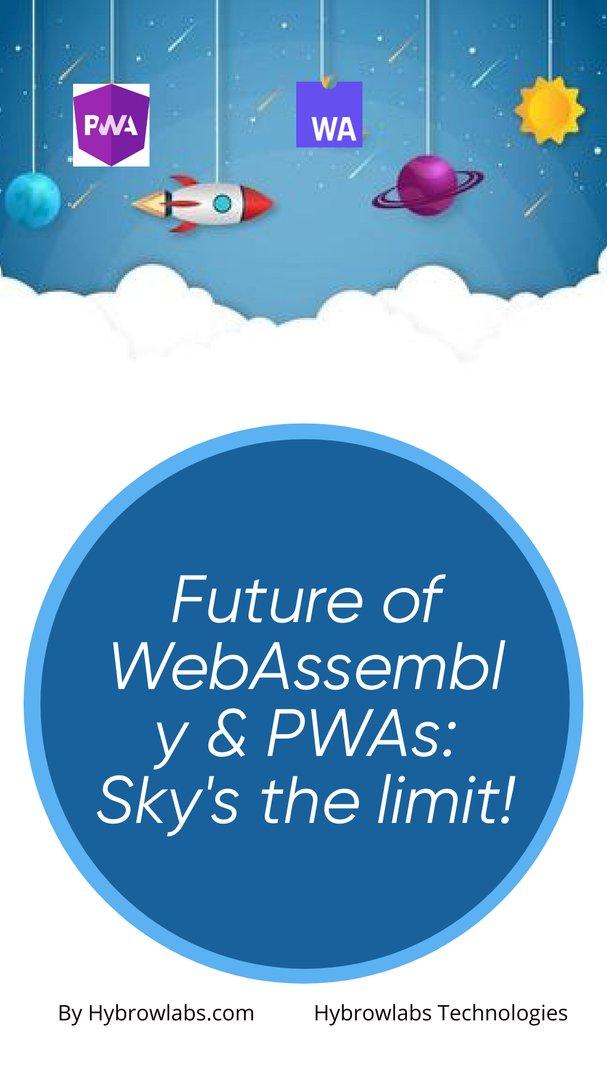Introduction:

WebAssembly is a groundbreaking technology that is altering the landscape of web application development. It serves as a virtual machine at a low level, enabling the execution of code within a web browser. By utilizing WebAssembly, software developers are empowered to write code in any programming language, compile it into a binary format, and subsequently operate it within a browser with performance that is virtually indistinguishable from that of native code. Consequently, this technology has emerged as an indispensable tool for constructing Progressive Web Apps (PWAs), which are web applications that offer users a user experience that is strikingly similar to native applications.
What is Progressive Web App?
A progressive web app, or PWA for short, is a specific form of a web app that gives users an experience similar to using a native app while being accessed through a web browser. PWAs use web technologies like HTML, CSS, and JavaScript to build a responsive and mobile-friendly interface with the main goal of operating seamlessly across different platforms and devices.
Key features of PWAs include:
- Using cached data or local storage, PWAs can be viewed even when there is no internet connection.
- An interface that looks like a native mobile app: PWAs have an interface that looks like a native mobile app and includes elements like app icons, splash screens, and full-screen mode.
- PWAs can provide users with push notifications, exactly like native apps.
- Better performance: PWAs are made to load rapidly and react immediately to user input.
- Secure connections: PWAs are delivered over HTTPS, which offers a connection that is more secure than HTTP.
Advantages of using PWAs over native apps include:
- Accessibility: PWAs can be used without users having to download and install a separate app through any current web browser.
- Cost-effectiveness: Because PWAs are constructed using web technologies that many developers are already familiar with, they may be developed and maintained more affordably than native apps.
- Reach: Because PWAs can be viewed on any device with a current web browser, they can reach a larger audience than native apps.
- Offline functionality: Without forcing users to download separate offline versions of the app, PWAs can offer a seamless offline experience.
- Performance has been enhanced since PWAs can provide quicker load times and better responsiveness than conventional mobile web apps, which can increase user engagement and retention.
WebAssembly and PWAs:
How WebAssembly enhances the performance of PWAs?
By enabling developers to run code in web browsers with almost native performance, WebAssembly (WASM) improves the overall performance of web apps, including PWAs. The following are some methods in which WebAssembly can improve PWA performance:
- Increased Execution Speed: WASM makes it possible to compile code in advance or Just-in-Time (JIT), which significantly increases the pace at which PWAs are executed and gives users a more responsive experience.
- Efficient Memory Usage: WASM is designed to use memory more effectively, allowing PWAs that use it to operate more swiftly and smoothly without using a lot of memory resources.
- Improved Parallelism: WASM can assist PWAs to carry out complicated data processing activities more effectively, hence enhancing overall performance, by enabling the execution of several threads within a web browser.
Case studies of companies using WASM in PWAs:
- Figma: Figma, a tool for collaborative design, enhanced the performance of its PWA using WebAssembly. Figma was able to decrease load times by up to 3x and boost overall performance by switching some of its essential components to WASM.
- Google Earth: Google Earth accelerates the rendering of 3D visuals in its PWA by using WebAssembly. Users may now view 3D maps in their browsers that are more realistic and engaging thanks to this.
- AutoCAD: To run in a web browser, AutoCAD, a computer-aided design programme, requires WebAssembly. Users no longer need to install AutoCAD on their local workstations to utilise the programme from any device.
How WASM reduces load times and improves the user experience?
- Faster Startup: WASM enables PWAs to load more quickly, even on slower connections, which can enhance the user experience by cutting down on wait times.
- Reduced Latency: PWAs can benefit from web assembly's ability to minimise latency, making it possible for users to interact with the app more swiftly and fluidly.
- Improved Response: WASM can help PWAs be more responsive and manage complicated tasks more effectively, especially on low-end devices, by enabling multi-threading and efficient memory utilisation.
Overall, WebAssembly is a potent tool for enhancing PWA speed, and businesses that want to offer their users high-quality online experiences are increasingly using it.
Advantages of WebAssembly in PWAs:

WebAssembly (WASM) provides manifold benefits for fabricating Progressive Web Applications (PWAs). These benefits include heightened performance, augmented user experience, uncomplicated development and maintenance, and amplified security and reliability.
- One of the most noteworthy advantages of utilizing WebAssembly is its capacity to enable developers to code in high-level languages such as C++ and Rust. Such code can then be compiled to operate at nearly native velocities within web browsers, consequently enhancing PWA performance by facilitating swifter loading times, superior responsiveness, and overall better functionality.
- In addition to heightened performance, WebAssembly can further augment the user experience of PWAs by enabling the incorporation of more intricate features such as real-time audio and video processing, 3D graphics rendering, and machine learning. This enhances the overall user experience, rendering PWAs more engaging, immersive, and ultimately more user-friendly.
- WebAssembly can also simplify the process of PWA development and maintenance by enabling developers to use familiar programming languages and tools. This can reduce development time, and debugging difficulties, and enhance overall code efficiency, resulting in faster turnaround times and reduced workload.
- Finally, WASM's inherent security measures make it an ideal technology for developing PWAs. WebAssembly operates within a sandboxed environment that prevents it from interacting with the broader system, thus reducing security vulnerabilities and enhancing reliability.
In conclusion, WebAssembly is a powerful technology that can enable developers to create high-performing, feature-rich PWAs that offer a superior user experience, are easier to develop and maintain, and provide increased security and reliability.
Challenges and Limitations of WebAssembly in PWAs:
Although WebAssembly (WASM) in Progressive Web Applications (PWAs) has numerous benefits, there are also several difficulties and restrictions that developers should be aware of, including:
- Older Browser Compatibility: WebAssembly is a newer technology that is not yet supported by all web browsers. Even while support is expanding quickly, certain older browsers still do not support WASM, which can restrict the accessibility of PWAs that rely on this technology.
- Security Issues: Even though WebAssembly is intended to be safer than existing web technologies, there may still be security issues if it is used improperly. Developers must take precautions to make sure their code is safe and resistant to assaults like buffer overflows.
- Restricted Usability for Non-JavaScript Developers: Even though WebAssembly is intended to be language-agnostic, it nonetheless necessitates some level of proficiency in programming languages like C++ and Rust. The necessity to learn a new language to use WebAssembly may limit its usability by developers who do not know JavaScript.
- Code Bloat: Although WebAssembly can aid in enhancing PWA performance, it can also lead to larger code sizes, which can prolong the time it takes for an app to launch. Those with slower connections or limited data plans may experience issues because of this.
Although WebAssembly can assist PWAs greatly, developers must be aware of the potential drawbacks and restrictions of this technology. Developers may fully benefit from web assembly's advantages while lowering its dangers and difficulties by carefully taking into account these aspects and putting best practices for security and optimization into practice.
Future of WebAssembly and PWAs:

The forthcoming progression of WebAssembly (WASM) and Progressive Web Apps (PWAs) appear optimistic, with various opportunities for advancement looming on the horizon.
Potential for WebAssembly to emerge as the prototype for web development:
As the backing for WebAssembly proliferates, it is plausible that it may arise as the prototype for web development. This would authorize developers to produce more competent and potent code that can execute over a plethora of platforms and devices. This could engender a substantial impact on the technique by which web applications are developed and distributed, as well as on the complete performance and user experience of these applications.
Potential for PWAs to substitute native mobile apps:
PWAs have already manifested their potential to furnish many of the same characteristics and functionality as native mobile apps, without necessitating users to download and install anything. As PWAs advance and improve, it is conceivable that they could eventually supplant native mobile apps entirely, administering a more seamless and efficient experience for users across all devices and platforms.
Apart from these possibilities, there are also numerous other potential applications for WebAssembly and PWAs, including in areas such as gaming, augmented reality, and virtual reality. As the technology evolves and matures, it is expected that we will witness even more exhilarating and innovative applications ensue.
Conclusion:
In conclusion, WebAssembly (WASM) is a game-changing technology that is playing an increasingly important role in the development of Progressive Web Apps (PWAs). By enabling developers to write code in languages like C++ and Rust that can run at near-native speeds in web browsers, WASM is helping to improve the performance, user experience, and security of PWAs.
As the technology continues to evolve and gain wider support, we will likely see even more exciting and innovative applications of WebAssembly in web development. From gaming and augmented reality to machine learning and more, the possibilities for using this technology are virtually limitless.
Overall, WebAssembly is a powerful tool that is transforming the way we think about web development and helping to drive the rise of PWAs as a new standard for web-based applications. By leveraging the advantages of WebAssembly, developers can create fast, efficient, and engaging apps that offer a superior user experience across all devices and platforms.
If you're interested in exploring the potential of WebAssembly for your web development needs, check out Hybrowlabs WebAssembly services. Our team of experts can help you harness the power of this groundbreaking technology to create high-performance, cutting-edge web applications.
FAQ’s:
1. What distinguishes WebAssembly from JavaScript?
JavaScript is a scripting language that is commonly used in web development and executed by web browsers. In contrast, WebAssembly is a low-level binary format that provides a secure, portable, and efficient method for executing code on the web. WebAssembly complements JavaScript and can be used together with it to boost performance and accomplish computationally intensive tasks.
2. How does WebAssembly improve the performance of PWAs?
WebAssembly advances the performance of Progressive Web Apps (PWAs) by presenting a more effective way to run code in the browser. The browser's virtual machine can compile and run WebAssembly code directly, which frequently leads to faster execution than JavaScript. This capability can be particularly advantageous for PWAs that necessitate complex calculations or high-speed processing, such as real-time graphics or video processing.
3. Is WebAssembly compatible with all browsers?
Most modern web browsers, including Chrome, Firefox, Safari, and Edge, support WebAssembly. However, some older browsers may not support it or may need additional configuration to enable its supporters.
4. Can WebAssembly be used for server-side applications?
WebAssembly can indeed be used for server-side applications. Despite its origins in web development, WebAssembly can also run outside of the browser environment, such as on servers or in standalone applications. This makes it a flexible technology suitable for a wide range of applications beyond web development.



.jpeg)


a3dc85.jpg)

.jpg)
fd8f11.png)


.jpg)
.jpg)